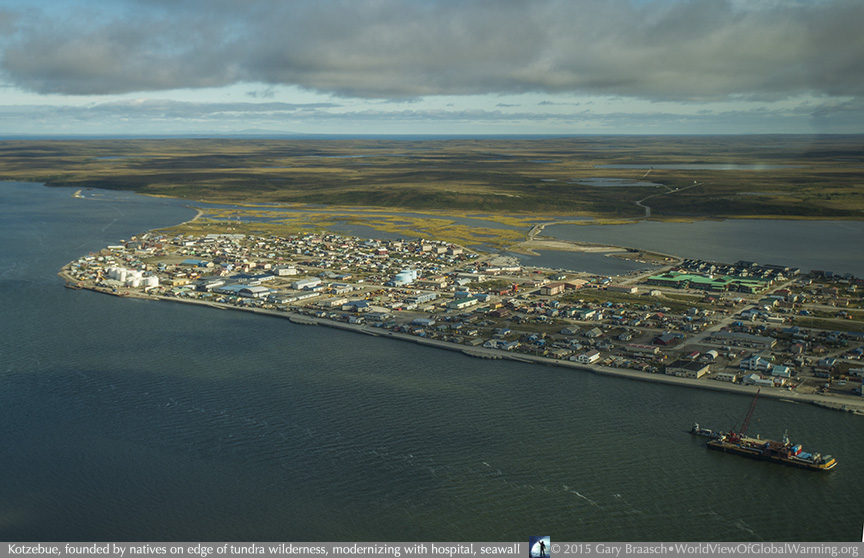Climate Photo of the Week
35,000 Pacific walrus are on Alaska Arctic Ocean beach haul out because preferred ice floe habitat has melted away. Walrus have been continuously seen near Shell Oil’s ships in drilling area, official says.
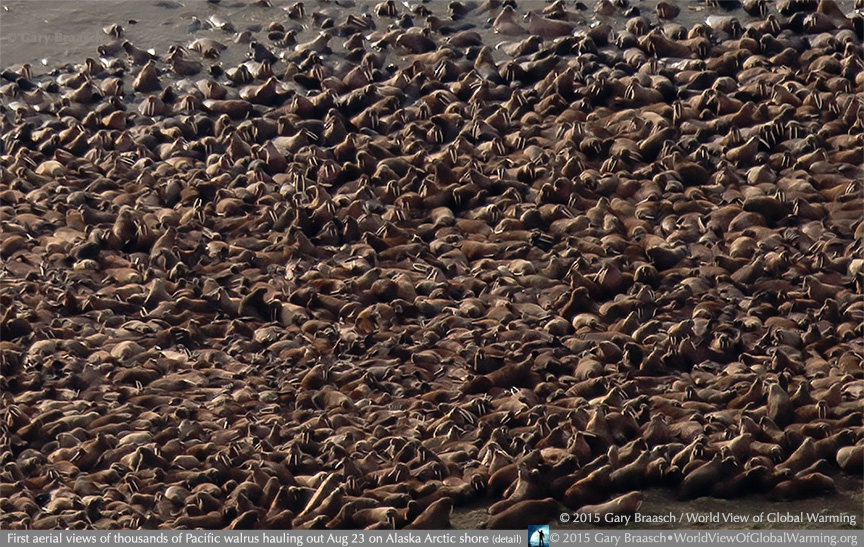
Thousands of Pacific walrus are coming ashore on the northwest Arctic coast of Alaska, repeating a migratory change for the walrus which USGS scientists have called a clear effect of loss of Arctic Ocean sea ice on which the animals rely. US Fish and Wildlife Service told Mashable’s Andrew Freedman that a storm shortly after the walrus were first seen on shore August 23 had apparently driven the mammals back into the water, but that after that tens of thousands were reported back on the beach near Point Lay, Alaska. This year’s “haul out” is the 7th time in the past 9 years that loss of the walrus normal summer ice floe habitat where females and young rest has forced the sea mammals to rest on shore in large aggregations. Wildlife biologists say this is stressful for walrus, makes feeding more difficult, and can result in animal deaths from the overcrowding on beaches. The haul out was first reported by Gary Braasch of World View of Global Warming after a small aircraft flight near Point Lay.
As the walrus swam more than 100 miles south from the preferred but now ice-free feeding ground, Hanna Shoal in the Chukchi Sea, many were passing close enough to the flotilla of Shell Oil ships on its drill site to be seen from the ships. James MacCracken, Supervisory Wildlife Biologist, U.S. Fish and Wildlife Service said in an August 28 press conference call, "We are getting reports from Shell daily” of walrus near the ships and rigs, and the talley so far is "700 walrus” seen by observers. When asked if all operations around the walrus by Shell are within the guidelines set by Interior Department regulation, MacCracken said, “Yes.” This is the first confirmation that protected sea mammals are swimming through the Burger oil leases which Shell just got permission to deep drill. Observers, employed by Shell and reporting to agencies of the Interior Department, are required under Shell’s permit for the drilling and other activities which might disturb or injure sea mammals.
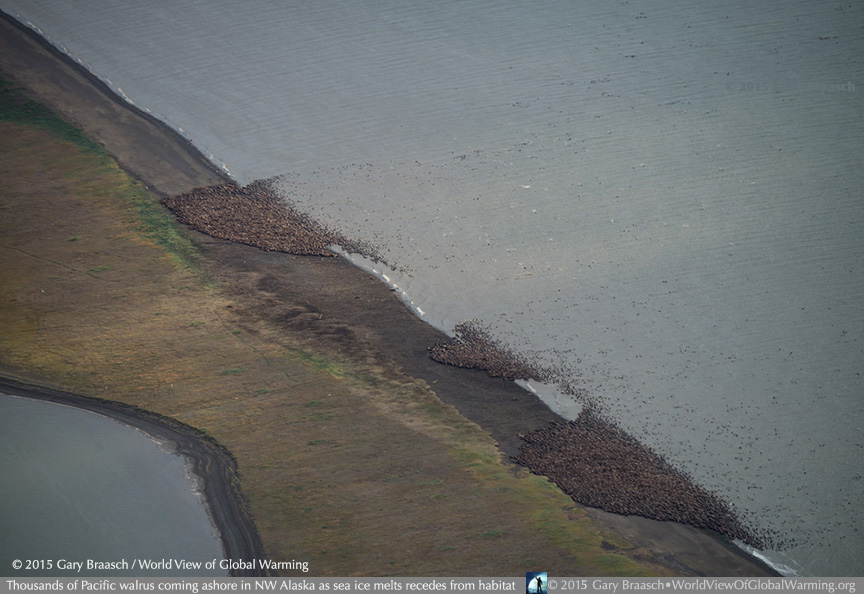
The press conference was also the first direct acknowledgement by the U.S. agencies in charge of studying and protecting the mammals that a new haul out had begun — nearly a week after the event actually started, and only three days before President Obama begins his tour of Alaska focusing on rapid climate change. Gary Braasch made the first photos of the haul out at about 7 pm August 23, after seeing on USGS maps of locations of geotagged walrus that several were stationary in the Point Lay area. FWS officials confirmed at the press conference that they had no photos of their own so far of the haul out, and Point Lay village President Leo Ferreira III said no one had been to the beach yet by boat, as of Friday. The walrus are subject to spooking and stampede by disturbance, which can trample and kill babies and young. In past years more than 100 have been found dead at other haul outs, apparently from stampedes. Marine Mammal Protection Act limits on approaching sea mammals are strict for this reason, and the village is cooperating fully with this protection, Ferreira said at the press conference.
Years of observations by scientists, mariners and natives document that until the sea ice began shrinking drastically in 2007, ice remained over shallow Chukchi sea areas where walrus spent the summers offshore. Walrus (Odobenus rosmarus divergens) have often left the water to rest on shore in many places across the Arctic shores of Russia and Alaska, but according to scientists it has most often been the males coming on land. The recent huge mixed aggregations of the sea mammals, which grow up to 12 feet long and may weigh up to 2 tons with females about half that weight, pose danger to the young and smaller animals from crushing and the spread of disease. This danger is increased with longer times on land — which is why this year’s early haul out is significant, since in other haul out years the animals have stayed until late September. The herd then moves toward Russia.
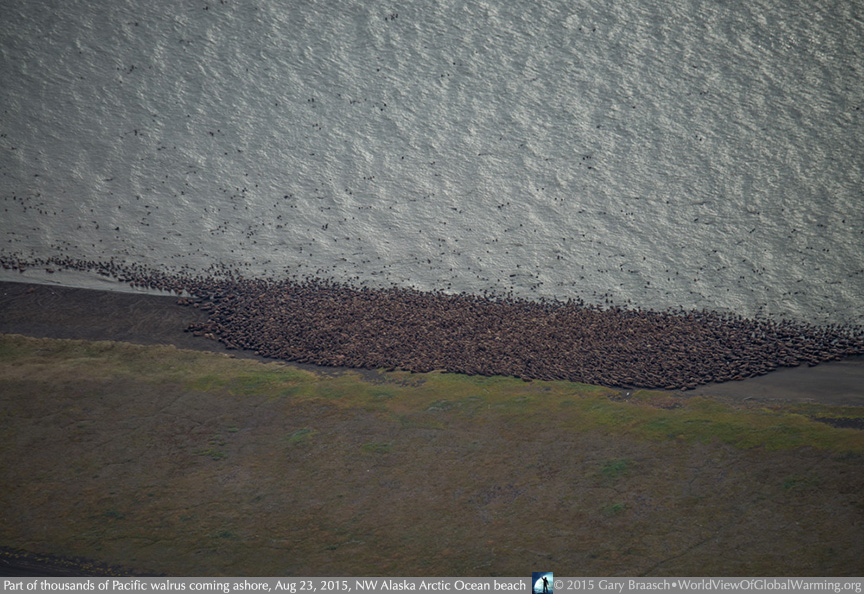
The huge sea mammals and young began coming up on this barrier island along Kasegaluk Lagoon about August 20, according to local natives. This is one of the earliest known summer haul outs of the walrus along the Alaska coast of the Chukchi Sea, according to wildlife biologists. Walrus coming up on Arctic beaches rather than staying on sea ice has occurred increasingly as Arctic sea ice melts faster and retreats far to the north of walrus feeding areas. According to USGS scientists, walrus, especially females with young, prefer to haul out and rest on remnant sea ice over shallow feeding areas about 100 miles off Alaska in the Chukchi Sea. That ice has disappeared in seven of the past nine years, forcing the animals and their young to swim southeast toward the beaches of NW Alaska, or to the Arctic Russian coast, to haul out. In some years, more than 30,000 animals have been on Alaska beaches, with some loss of life due to crowding and crushing and disease.
This year’s haul out occurred just before President Obama visited Alaska, including Kotzebue, which is about 200 miles south of the walrus. The President spoke vigorously of climate change while standing before thawing glaciers and speaking with native fishers. Loss of sea ice and early and frequent walrus haul outs are also major effects of climate warming in the Arctic, as Presidential Science Advisor John Holdren said while showing Gary Braasch’s walrus photo to an international Arctic climate meeting in Anchorage during the President’s trip. Years of observations by scientists, mariners and natives document that until the sea ice began shrinking drastically in 2007, ice remained over shallow Chukchi sea areas where walrus spent the summers offshore. Walrus (Odobenus rosmarus divergens) have often left the water to rest on shore in many places across the Arctic shores of Russia and Alaska, but according to scientists it has most often been the males coming on land. The recent huge mixed aggregations of the sea mammals, which grow up to 12 feet long and may weigh up to 2 tons with females about half that weight, pose danger to the young and smaller animals from crushing and the spread of disease. This danger is increased with longer times on land — which is why this year’s early haul out is significant, since in other haul out years the animals have stayed until late September. The herd then moves toward Russia
Administration gives Shell the go ahead for first deep oil drilling into Arctic Ocean
15 years of World View of Global Warming, documenting climate change 1999-2015
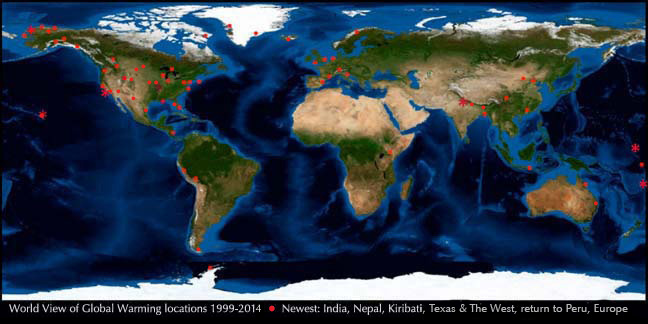
This project would be impossible without scientists and observers around the world who have provided hundreds of scientific contacts and papers. See Background, Advisors, and Reference for documentation, funders and major advisors, without whom I could not complete the work.
World View of Global Warming is a project of the Blue Earth Alliance, Seattle Washington, a 501(c)3 tax-exempt organization. The project is supported entirely by donations, grants, and license fees for the photographs. Please see information about how to contribute.
For other information about Gary Braasch's climate change projects and books, please see the books Earth Under Fire and How We Know What We Know About Our Changing Climate, and the exhibit "Climate Change in Our World" at the Books and Exhibits link on the top menu of this page.
COPYRIGHT NOTICE:
Photography and text Copyright © 2005 - 2017 (and before) Gary Braasch All rights reserved. Use of photographs in any manner without permission is prohibited by US copyright law. Photography is available for license to publications and other uses. Please contact requestinformation@worldviewofglobalwarming.org. View more of Gary Braasch's photography here.



